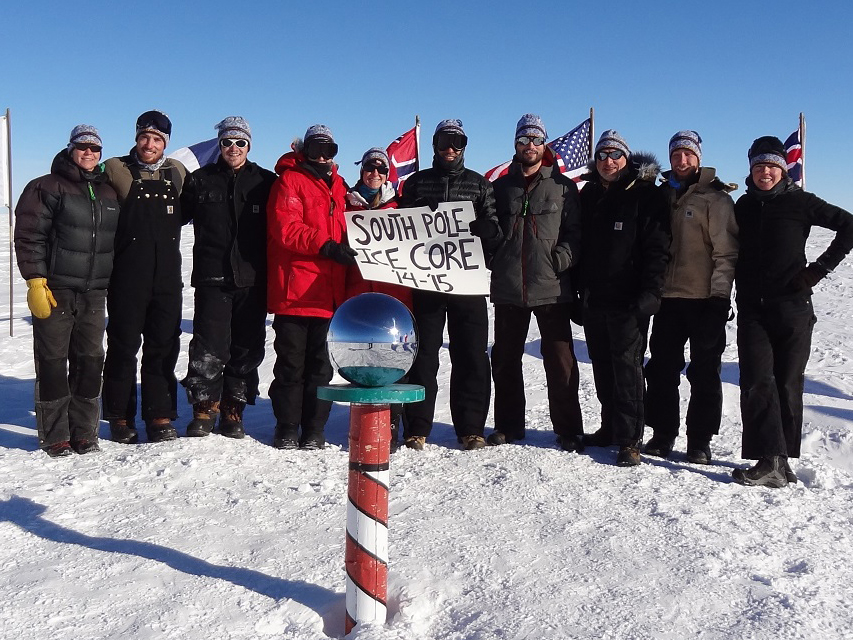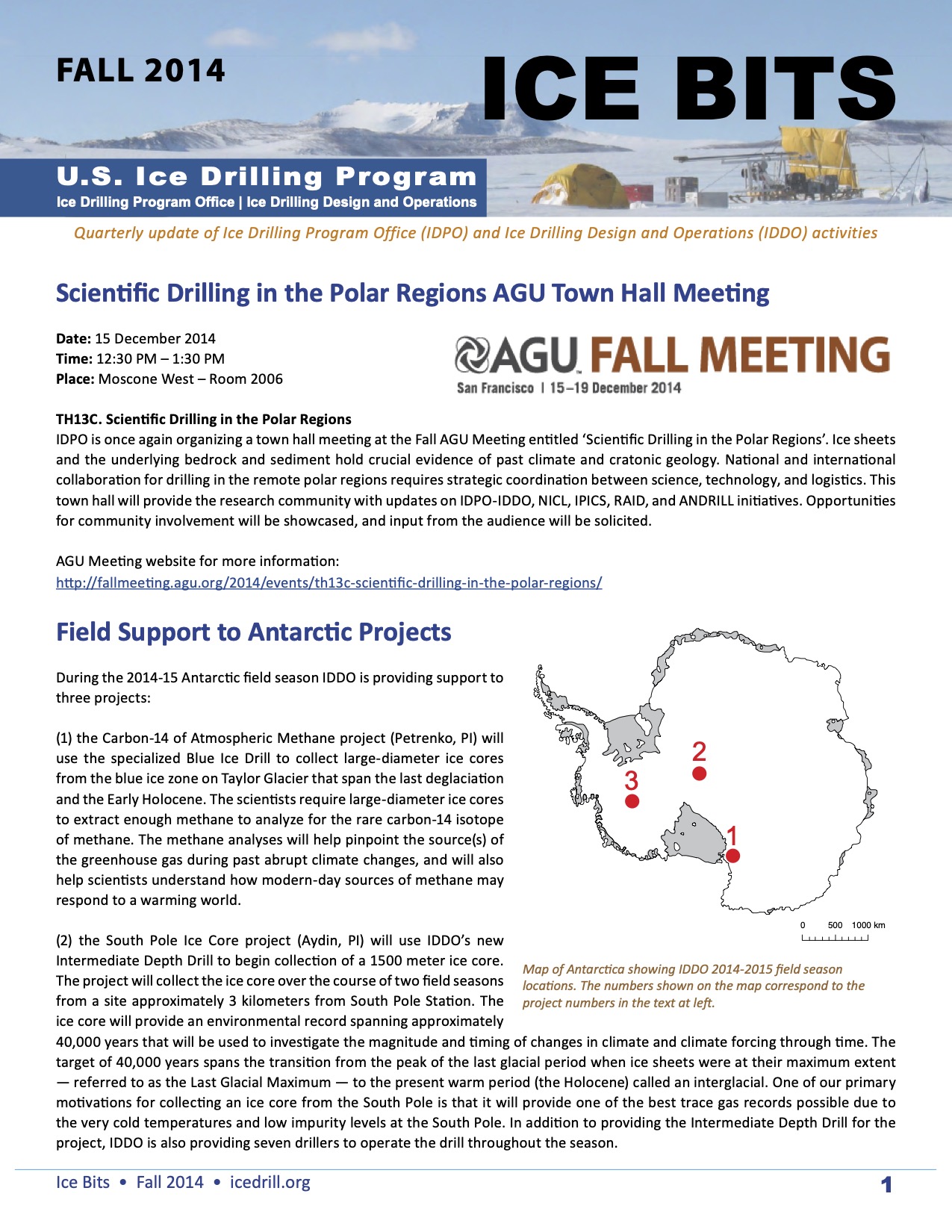Scientific Drilling in the Polar Regions AGU 2014 Town Hall Meeting
- Long Range Plans
- Meetings/ Workshops
Date: 15 December 2014
Time: 12:30 PM - 1:30 PM
Place: Moscone West - Room 2006
TH13C. Scientific Drilling in the Polar Regions
IDPO is once again organizing a town hall meeting at the Fall AGU Meeting entitled 'Scientific Drilling in the Polar Regions'. Ice sheets and the underlying bedrock and sediment hold crucial evidence of past climate and cratonic geology. National and international collaboration for drilling in the remote polar regions requires strategic coordination between science, technology, and logistics. This town hall will provide the research community with updates on IDPO-IDDO, NICL, IPICS, RAID, and ANDRILL initiatives. Opportunities for community involvement will be showcased, and input from the audience will be solicited.
AGU Meeting website for more information:
http://fallmeeting.agu.org/2014/events/th13c-scientific-drilling-in-the-polar-regions/
Field Support to Antarctic Projects (2014/2015)
- Fieldwork
During the 2014-15 Antarctic field season IDDO is providing support to three projects:
(1) the Carbon-14 of Atmospheric Methane project (Petrenko, PI) will use the specialized Blue Ice Drill to collect large-diameter ice cores from the blue ice zone on Taylor Glacier that span the last deglaciation and the Early Holocene. The scientists require large-diameter ice cores to extract enough methane to analyze for the rare carbon-14 isotope of methane. The methane analyses will help pinpoint the source(s) of the greenhouse gas during past abrupt climate changes, and will also help scientists understand how modern-day sources of methane may respond to a warming world.
(2) the South Pole Ice Core project (Aydin, PI) will use IDDO's new Intermediate Depth Drill to begin collection of a 1500 meter ice core. The project will collect the ice core over the course of two field seasons from a site approximately 3 kilometers from South Pole Station. The ice core will provide an environmental record spanning approximately 40,000 years that will be used to investigate the magnitude and timing of changes in climate and climate forcing through time. The target of 40,000 years spans the transition from the peak of the last glacial period when ice sheets were at their maximum extent — referred to as the Last Glacial Maximum — to the present warm period (the Holocene) called an interglacial. One of our primary motivations for collecting an ice core from the South Pole is that it will provide one of the best trace gas records possible due to the very cold temperatures and low impurity levels at the South Pole. In addition to providing the Intermediate Depth Drill for the project, IDDO is also providing seven drillers to operate the drill throughout the season.
(3) In support of the ongoing work at WAIS Divide, IDDO will assist with borehole logging operations, and will also disassemble the Deep Ice Sheet Coring (DISC) Drill system and prepare it for transport back to Madison, Wisconsin. The borehole logging operations consist of temperature (Clow, PI), seismic (Peters, PI), optical (Bay and Talghader, PIs) and acoustic televiewer logging (Pettit and Obbard, PIs). The temperature data will be used to refine estimates of the geothermal heat flow at the site, the melting rate at the base of the ice sheet, and to reconstruct past surface temperatures using borehole paleothermometry. The seismic data will be used to study the ice fabric, which will be linked to the physical properties of the WAIS Divide ice core. The optical data will be used to study the dust, crystal structure and ice fabric at the site. The acoustic televiewer will measure the shape and tilt of the borehole at high resolution to form a basis for measuring future changes in borehole shape and tilt. The changes in borehole shape and tilt over time will be used to study ice deformation.
Education and Public Outreach (2014 Fall)
- Education/ Outreach
A reminder for scientists who attended the WAIS Divide conference in La Jolla, this past September: To have your recent scientific results be 'front and center' in IDPO's outreach messages to teachers, television, and the public, please access the media information files, located on pp. 78-79 (pp. 80-81 if printing) of the WDC Handout on the conference thumb drive, and return the requested information to Linda Morris via fax at (603) 646-9795 or via email, at linda.m.morris at dartmouth.edu. This will help Linda to showcase knowledge of the community's many recent successes!
For everyone: Please share the following information about an upcoming National Science Teacher Association (NSTA) webinar with your education networks, and others seeking the latest information. The event is free.
SPICE Core: Investigating Past Climate at the South Pole
What's the latest in Antarctic paleo-climate research? On December 10, 2014, this web seminar, targeting educators of students in grades 7-12, will introduce participants to the nation's newest ice core expedition...SPICE Core! Investigators seeking data from the past 40,000 years are drilling a 1500 meter ice core to study chemical isotopes, tiny particles called aerosols and atmospheric gases trapped in the earth's great southern ice sheet. The goal is to investigate environmental change since the last glacial/interglacial transition. Why was the South Pole targeted? What criteria affect the specific site selection for drilling? What new kinds of technology were required? Dr. T.J. Fudge will answer your questions, and share what it's like to work in the Pole's extreme environment.
A related, video-enhanced educational activity, focusing on "Polar Science and Engineering", will be presented by Linda Morris for you to share with your students. The interactions modeled in the video between scientists and engineers will serve as the basis of a reflective activity, Drilling Back Through Time, that introduces the students in your classroom to the NGSS's "Scientific and Engineering Practices". Educational resources from the US Ice Drilling Program will be showcased.
Date: Wednesday, December 10, 2014
Time: 6:30 p.m. ET / 5:30 p.m. CT / 4:30 p.m. MT / 3:30 p.m. PT
Registration: http://learningcenter.nsta.org/products/symposia_seminars/NSF/webseminar6.aspx
Presenters:
Dr. T.J. Fudge, Postdoctoral Researcher, University of Washington, Earth & Space Sciences
Ms. Linda M. Morris, Director of Education & Public Outreach, US Ice Drilling Program Office, Dartmouth College
For further information, contact Linda at linda.m.morris at dartmouth dot edu.
2014 Technical Advisory Board Meeting
- Technical Assistance Board
- Meetings/ Workshops
IDDO held its annual Technical Advisory Board (TAB) Meeting in Madison, WI on September 9-10, with drilling experts from all over the world and from a wide variety of fields. The meeting was well attended by 9 of 12 TAB members, one proxy TAB member, IDDO staff, members from IDPO, former IDDO PI Charlie Bentley and new IDDO PI Mark Mulligan. IDDO presented on the current status of IDDO field projects, equipment development projects and equipment maintenance and upgrade efforts. As with each TAB meeting, IDDO gained very valuable feedback from board members on equipment development projects, ideas regarding new technologies in ice drilling and other fields, as well as input on field project logistics.
Notes from the meeting will be available at /about/technical-assistance-board.
Media Kit (2014 Fall)
- Education/ Outreach
The 2014 Fall IDPO-IDDO Media Kit is now available for download. While the Media Kit is written for the media, it is a good resource for anyone interested in learning more about IDPO-IDDO. The Media Kit can be downloaded at:
https://www.icedrill.org/news/media.shtml
Field Support to Science Projects (2014 Fall)
- Fieldwork
Current – Antarctic 2014-2015
- Carbon-14 from Taylor Glacier Blue Ice Cores (Petrenko)
- South Pole 1500-meter Ice Core (Aydin)
- WAIS Divide Borehole Temperature Logging (Clow)
- WAIS Divide Fabric and Texture Logging (Pettit and Obbard)
- WAIS Divide Optical Logging (Bay and Talghader)
- WAIS Divide Vertical Seismic Profiling (Riverman)
Upcoming – Arctic 2015
- Cosmogenic Carbon-14 in Polar Firn, Greenland (Petrenko)
- Disko Bay and Baffin Bay Firn and Ice Cores, Greenland (Das)
- Greenland Aquifer Investigation (Forster)
- Microbes and Ice Formation in Inland Waters, USA (McKay)
Upcoming – Antarctic 2015-2016
- Aerosol Fluxes to Taylor Dome/Glacier (Aciego)
- Carbon-14 from Taylor Glacier Blue Ice Cores (Petrenko)
- Ohio Range Ice-Rock Interface Samples (Mukhopadhyay)
- South Pole 1500-meter Ice Core (Aydin)
For the latest information on our current and upcoming field projects, visit:
https://icedrill.org/fieldwork



